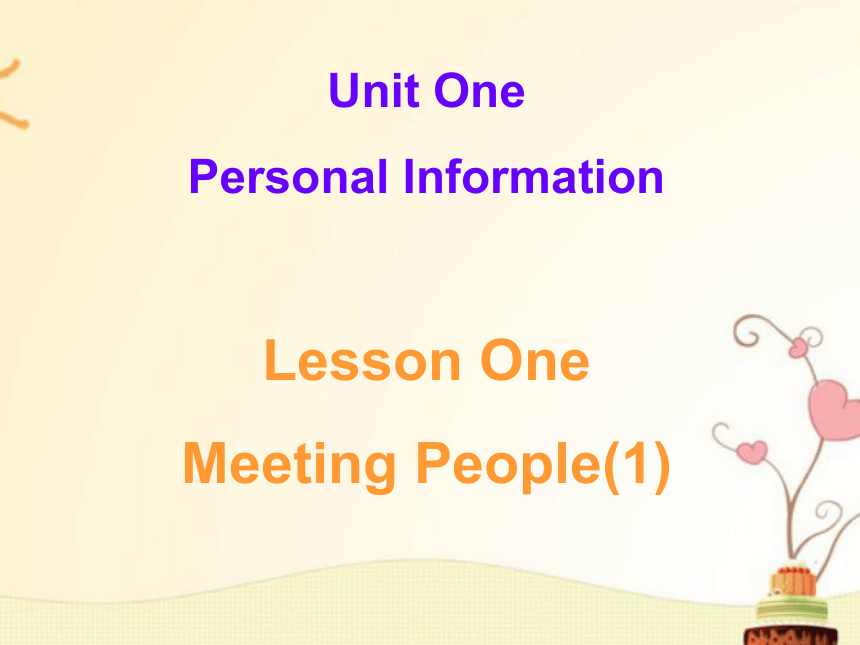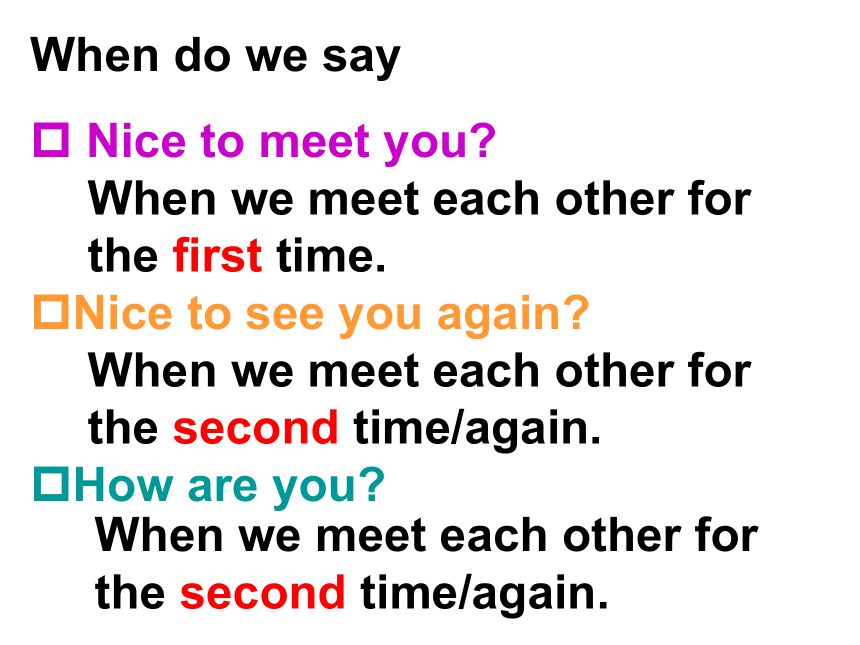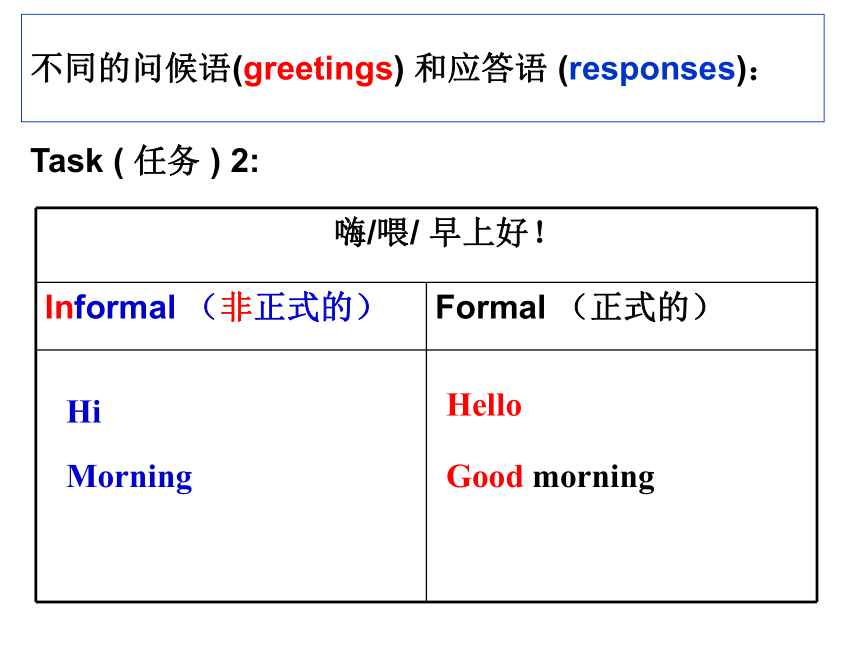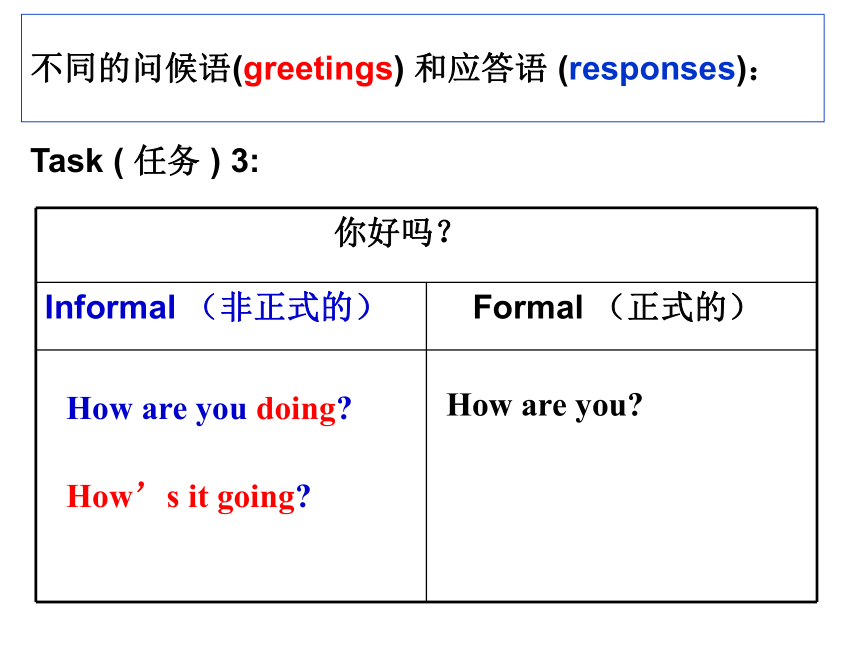Unit 1 Personal Information Unit 1 Lesson 1 Meeting People 课件(4课时,58张PPT,无素材)
文档属性
| 名称 | Unit 1 Personal Information Unit 1 Lesson 1 Meeting People 课件(4课时,58张PPT,无素材) |

|
|
| 格式 | zip | ||
| 文件大小 | 5.4MB | ||
| 资源类型 | 教案 | ||
| 版本资源 | 上海新世纪版 | ||
| 科目 | 英语 | ||
| 更新时间 | 2019-10-25 20:53:00 | ||
图片预览












文档简介
课件58张PPT。Unit One
Personal Information
Lesson One
Meeting People(1)
A Children's SongHow Do You Do?
How do you do, Mary, Michael?
How do you do?
Is there anything that we can do for you?
We are glad to welcome you,
And we hope you like us, too.
How do you do, Mary, Michael?
How do you do?Nice to meet you.Nice to meet you, too.What can you see in the picture?
What are they doing?
What are they saying?They are greeting each other.A B Listen to two different conversations and match them to the right pictures above.When do we say
Nice to meet you?
Nice to see you again?
How are you?When we meet each other for the first time.When we meet each other for the second time/again.When we meet each other for the second time/again.Read the two dialogues on P4 and P5 and then complete the tasks below.Task ( 任务 ) 1:
a. Which conversation is more formal (更正式的 ),
Conversation A or B ? .
b. 遇到熟悉的老朋友老师、长辈时,你们会用
Conversation 中的 greetings & responses;
c. 遇到刚认识的朋友、老师、长辈时,你们会用
Conversation 中的 greetings & responses; B A B不同的问候语(greetings) 和应答语 (responses):Task ( 任务 ) 2:
HiHelloMorningGood morning不同的问候语(greetings) 和应答语 (responses):Task ( 任务 ) 3:
How are you?How are you doing?How’s it going?不同的问候语(greetings) 和应答语 (responses):Task ( 任务 ) 4:
Fine,
OK,
Great,
Not (too) bad,I’m fine, thank you.
/ about you?thanks. And you?HowWhat不同的问候语(greetings) 和应答语 (responses):Task ( 任务 ) 5:
OK, thanks. I’m very well
(Very well….)I’m pretty well
(Pretty well….)When you meet a new friend for the first time, you say:A: Nice to you.
B: Nice to you, ./ .meetmeet tooWhen you meet your friend again, you say:
A: Nice to you .
B: Nice to you, ./ .
Me, too.see again see tooMe, tooACTINGWang Ping meets Alice White at a party for the first time.
Wang Ping meets Alice White at school again.A: Wang Ping B: Alice WhiteTask 2 被介绍时的问候语(greetings) 和应答语 (responses):Nice to meet you, too How do you do 这种问候语已经过时,现在几乎不用。Task ( 任务 ) 1:
a. Which conversation is more formal (更正式的 ),
Conversation A or B ? .
b. 同龄的同学、朋友之间会用
Conversation 中的 greetings & responses;
c. 老师、长辈之间会用
Conversation 中的 greetings & responses; B A BRead the two dialogues on P5 and then complete the tasks below.Complete the conversation:
Li Hui: Good morning, Mr. Smith. _____________?
Mr. Smith: ______________, thanks. ________________?
Li Hui: ___________ well, ______________.Feedback ExerciseAssignmentListen to the tape-recording of the text and read after it. It is better if you can read the text fluently.
Preview Lesson Notes and finish Comprehension Check.
Copy the words on P11 in SB.Unit One
Personal Information
Lesson One
Meeting People(2)Wang Ping meets Alice White for the third time.Making up a dialogue:A: Wang Ping B: Alice WhiteLi Hui, Wang Ping and Julia meet at the gate of No.1 Junior High School.Wang PingJulia BrownLi HuiWhat do Li Hui and Julia say?
Do they meet for the first time?
Do Wang Ping and Julia meet for the first time?
What should Li Hui do?Hello, Julia. How are you doing?Very well, thank you. What about you?Do you know how Li Hui introduces Wang Ping to Julia? Let’s listen to the text and try to find out the answer.Julia, this is Wang Ping. He’s monitor of my class. This is Julia Brown. She’s my friend. She’s from America.What do Wang Ping and Julia say to each other after Li Hui introduces them?Wang Ping:
Julia:
Wang Ping:
Julia:Nice to meet you, Julia.Nice to meet you, too, Wang Ping.Which class are you in?I’m in Class One, Junior Two.Listen to the text one more time and try to complete the dialogue of the text.Li Hui: Hello, Julia. How are you ____________?
Julia: _____________, thank you. _______________ you?
Li Hui: Fine, __________. Julia, ____________ Wang Ping. He’s ____________ of my class. ____________ Julia Brown. __________ my friend. __________ from America.
Wang Ping: ______________________________, Julia.
Julia: _____________________, too, Wang Ping.
Wang Ping: Which _______ are you _______?
Julia: I’m in ________ One, ________ Two.
Li Hui: Oh, it’s time for class. Come on, let’s go to the classroom.doingVery wellWhat aboutthanksthis ismonitorThis isShe’sShe’sNice to meet youNice to meet youclassinClass Junior ACTINGWang Ping meets Alice White at a party for the first time. Li Hui is introducing them to each other.
Li Hui is introducing his maths teacher Mr Zhang to his new English teacher Miss Brown.A: Wang Ping B: Alice White C: Li HuiA: Mr. Zhang B: Miss Brown C: Li HuiChoose the best answers on P1 in WB.
Complete the conversation 2 on P2 in WB.Feedback ExerciseAssignmentRead and recite the text.
Finish Comprehension Check on the Text on P1 in WB.
Finish conversation3 and 4 on P2 in WB.Unit One
Personal Information
Lesson One
Meeting People(3)A Children's SongHow Do You Do?
How do you do, Mary, Michael?
How do you do?
Is there anything that we can do for you?
We are glad to welcome you,
And we hope you like us, too.
How do you do, Mary, Michael?
How do you do?Personal pronoun (人称代词)单数形式复数形式 (…们)I am in Class One, Junior Two.
Nice to meet you.
He’s monitor of my class.主语用主格;动词前面的是主语。宾语用宾格;动词和介词后面用宾格。表示某人的用所有格。用括号里代词的正确形式完成句子:
That girl is Zhang Hua.
_______ English name is Julia. (she)
2. What’s ______ phone number?(you)
3. ---Excuse ______, are you a student?
---Yes. am. (my)
4. Class is over. Let _____ go and play table tennis.(we)Her yourmeIus用括号里代词的正确形式完成句子:
1. Jack is a good boy. Everybody likes . (he)
2. I have many picture-books.
I like reading very much. (they)
3. has a lovely dog. (her)
color is black. (it)
4. David Tao is English teacher.
He teaches English. (we)himthemSheour usItsChoose the best answer:
are in the same class.
A. I and you B. Me and you
C. You and I D. You and me
are good friends.
A. He and I B. I and he
C. He and me D. His and I
3. are in the same school.
A. He, you and I B. I, he and you
C. I, you and he D. You, he and ICAD做笔记:
you and I / we ….
2. you, he/she/they and I/we….
3. he/she/they and I/we ….第二人称总在前;
第三人称夹中间;
第二不在三提前;
第一人称不领先;IyourMymeyoumeyouyouIyouIP6yourtheyTheirmethemSheyouyouTheyDeveloping Skills(技能提高) Listening, Ex. 2, p7
1. , thank you. How ?
2. do you ?
3. , thanks. you?
4. Nice , Mr Park.
5. to meet you, .
6. Nice to you, .
Fineabout youHowdoVery wellWhat about(How about)to meet youNicetooseetoo Complete the following sentences with personal pronouns in their proper forms on P2 in WB.Feedback ExerciseAssignmentRead aloud the words and the text.
Complete the EX 3-50n P2-4 in WB.
Choose the best responses for Speaker B. Then act the dialogue out in pairs on P4 in WB.Unit One
Personal Information
Lesson One
Meeting People(4)Rainy and grey,
Yesterday and today,
So rainy and grey,
We must stay in to play.A RHYMERemember:字母a在开音节中发/ ei /。
字母a在闭音节中发/ ? /。
以元音字母结尾的音节叫开音节。
以辅音字母结尾的音节叫闭音节。A cat and a rat sat on a mat,
They were having a chat.
The cat was glad,
But the rat was sad.A RHYMEListen to the dialogue. Pay attention to the intonation.A: Are you in Class One ?
B: Yes , I am . And you ?
A: I’m in Class Two .Listen and choose the best answer. (P4 in WB)
Li Hui is going to the cinema with _______.
A. Mr. Smith B. his dad and mum C. his classmates
2. Li Hui meets his _____ teacher at the gate of the cinema.
A. English B. maths C. Chinese
3. Li Hui’s father and mother are glad to ___ Mr. Smith ___.
A. see, again B. introduce, to Li Hui C. meet, for the first time.
4. Mr. Smith is from ____.
A. America B. Britain C. Australia (澳大利亚)
5. Mr. Smith likes Shanghai because it is _____.
A. modern B. big C. famous(有名的)B A C B A Cross out (×) the questions you should NOT ask when you first meet someone on P8 in SB.
Pay attention to this:
在以英语为母语的国家,人们初次见面,不打听对方的年龄、婚姻状况、体重、薪水和所购物品价格等。READING Good afternoon, Class. First, let me introduce myself. My name’s John Smith, but I’d like you to call me John. I’m from Britain. I’m very glad to be your teacher. I teach English, and I often go to the English Corner after school. I talk with the students there in English and make friends with them.True or FalseMr Smith is meeting the class for the first time.
He is introducing himself to his students.
He would like his students to call him Mr Smith.
He is teaching the class English and maths.
He gives his students classes at the English Corner.T T F F F John talks with the students and makes friends with themWhich is true?1. 让我自我介绍一下。
a. Let me introduce me.
b. Let me introduce myself.
c. Let me to introduce myself.True2. 我希望你们叫我 David。
a. I’d like you to call I David.
b. I’d like you call me David.
c. I’d like you to call me David.introduce oneself (to sb)
向…作自我介绍Truewould like + sb + to do sth
希望/想…做…Which is true?3. John Smith 是英国人 (来自英国)。
a. John Smith is British.
b. John Smith is from British.
c. John Smith is from Britain.TrueTrue“英国人(的)”“英国”我很高兴做你们的老师。
a. I’m glad to do your teacher.
b. I’m glad to be your teacher.
c. I’m glad be your teacher.Truebe glad + to do sth
很高兴做…Which of them is true? John 与那里的学生用英语交谈。
a. John talks with the students there in English.
b. John talks the students there in English.
c. John talks to the students there in English.
TrueTruetalk with/ to + sb + in English 与…用英语交谈John向他的学生作了自我介绍。
a. John introduces him to his students.
b. John introduces he to his students.
c. John introduces himself to his students.True introduce + oneself (反身代词)What’s the English for the Chinese?向…作自我介绍:
2. 想要 + 某人+ 做…:
3. 叫我 Tom:
4. 很高兴做…:
introduce oneself to sbwould like sb + to do sthcall me Tombe glad + to do sthWhat’s the English for the Chinese?
5.教我们英语:
6.去英语角:
7、与某人用英语交谈: teach us Englishgo to the English Cornertalk with/ to + sb + in EnglishTranslate into English:
1. 首先, 让我来作自我介绍。
2. 我的名字叫 John Smith,可我希望你们叫我 John。
3. 我是英国人。
4. 我很高兴当你们的老师。
5. 我用英语与那里的学生交谈。Feedback ExerciseAssignmentRead and recite Mr Smith’s introduction.
Finish the two tasks below.
Task 1: Answer the following questions
according to the text.
Task 2: Complete the passage.
Look at Li Ping’s resume on P12 in WB and write an advertisement for her to look for a pen-pal. Use the advertisement about Edward to help you. Task 1: Answer the following questions according to the text.Task 2: complete the passage.Let’s complete ( 完成 ) the passage (段落 ):14years oldBritainEnglishstudiesJunior High SchoolinClass One
Personal Information
Lesson One
Meeting People(1)
A Children's SongHow Do You Do?
How do you do, Mary, Michael?
How do you do?
Is there anything that we can do for you?
We are glad to welcome you,
And we hope you like us, too.
How do you do, Mary, Michael?
How do you do?Nice to meet you.Nice to meet you, too.What can you see in the picture?
What are they doing?
What are they saying?They are greeting each other.A B Listen to two different conversations and match them to the right pictures above.When do we say
Nice to meet you?
Nice to see you again?
How are you?When we meet each other for the first time.When we meet each other for the second time/again.When we meet each other for the second time/again.Read the two dialogues on P4 and P5 and then complete the tasks below.Task ( 任务 ) 1:
a. Which conversation is more formal (更正式的 ),
Conversation A or B ? .
b. 遇到熟悉的老朋友老师、长辈时,你们会用
Conversation 中的 greetings & responses;
c. 遇到刚认识的朋友、老师、长辈时,你们会用
Conversation 中的 greetings & responses; B A B不同的问候语(greetings) 和应答语 (responses):Task ( 任务 ) 2:
HiHelloMorningGood morning不同的问候语(greetings) 和应答语 (responses):Task ( 任务 ) 3:
How are you?How are you doing?How’s it going?不同的问候语(greetings) 和应答语 (responses):Task ( 任务 ) 4:
Fine,
OK,
Great,
Not (too) bad,I’m fine, thank you.
/ about you?thanks. And you?HowWhat不同的问候语(greetings) 和应答语 (responses):Task ( 任务 ) 5:
OK, thanks. I’m very well
(Very well….)I’m pretty well
(Pretty well….)When you meet a new friend for the first time, you say:A: Nice to you.
B: Nice to you, ./ .meetmeet tooWhen you meet your friend again, you say:
A: Nice to you .
B: Nice to you, ./ .
Me, too.see again see tooMe, tooACTINGWang Ping meets Alice White at a party for the first time.
Wang Ping meets Alice White at school again.A: Wang Ping B: Alice WhiteTask 2 被介绍时的问候语(greetings) 和应答语 (responses):Nice to meet you, too How do you do 这种问候语已经过时,现在几乎不用。Task ( 任务 ) 1:
a. Which conversation is more formal (更正式的 ),
Conversation A or B ? .
b. 同龄的同学、朋友之间会用
Conversation 中的 greetings & responses;
c. 老师、长辈之间会用
Conversation 中的 greetings & responses; B A BRead the two dialogues on P5 and then complete the tasks below.Complete the conversation:
Li Hui: Good morning, Mr. Smith. _____________?
Mr. Smith: ______________, thanks. ________________?
Li Hui: ___________ well, ______________.Feedback ExerciseAssignmentListen to the tape-recording of the text and read after it. It is better if you can read the text fluently.
Preview Lesson Notes and finish Comprehension Check.
Copy the words on P11 in SB.Unit One
Personal Information
Lesson One
Meeting People(2)Wang Ping meets Alice White for the third time.Making up a dialogue:A: Wang Ping B: Alice WhiteLi Hui, Wang Ping and Julia meet at the gate of No.1 Junior High School.Wang PingJulia BrownLi HuiWhat do Li Hui and Julia say?
Do they meet for the first time?
Do Wang Ping and Julia meet for the first time?
What should Li Hui do?Hello, Julia. How are you doing?Very well, thank you. What about you?Do you know how Li Hui introduces Wang Ping to Julia? Let’s listen to the text and try to find out the answer.Julia, this is Wang Ping. He’s monitor of my class. This is Julia Brown. She’s my friend. She’s from America.What do Wang Ping and Julia say to each other after Li Hui introduces them?Wang Ping:
Julia:
Wang Ping:
Julia:Nice to meet you, Julia.Nice to meet you, too, Wang Ping.Which class are you in?I’m in Class One, Junior Two.Listen to the text one more time and try to complete the dialogue of the text.Li Hui: Hello, Julia. How are you ____________?
Julia: _____________, thank you. _______________ you?
Li Hui: Fine, __________. Julia, ____________ Wang Ping. He’s ____________ of my class. ____________ Julia Brown. __________ my friend. __________ from America.
Wang Ping: ______________________________, Julia.
Julia: _____________________, too, Wang Ping.
Wang Ping: Which _______ are you _______?
Julia: I’m in ________ One, ________ Two.
Li Hui: Oh, it’s time for class. Come on, let’s go to the classroom.doingVery wellWhat aboutthanksthis ismonitorThis isShe’sShe’sNice to meet youNice to meet youclassinClass Junior ACTINGWang Ping meets Alice White at a party for the first time. Li Hui is introducing them to each other.
Li Hui is introducing his maths teacher Mr Zhang to his new English teacher Miss Brown.A: Wang Ping B: Alice White C: Li HuiA: Mr. Zhang B: Miss Brown C: Li HuiChoose the best answers on P1 in WB.
Complete the conversation 2 on P2 in WB.Feedback ExerciseAssignmentRead and recite the text.
Finish Comprehension Check on the Text on P1 in WB.
Finish conversation3 and 4 on P2 in WB.Unit One
Personal Information
Lesson One
Meeting People(3)A Children's SongHow Do You Do?
How do you do, Mary, Michael?
How do you do?
Is there anything that we can do for you?
We are glad to welcome you,
And we hope you like us, too.
How do you do, Mary, Michael?
How do you do?Personal pronoun (人称代词)单数形式复数形式 (…们)I am in Class One, Junior Two.
Nice to meet you.
He’s monitor of my class.主语用主格;动词前面的是主语。宾语用宾格;动词和介词后面用宾格。表示某人的用所有格。用括号里代词的正确形式完成句子:
That girl is Zhang Hua.
_______ English name is Julia. (she)
2. What’s ______ phone number?(you)
3. ---Excuse ______, are you a student?
---Yes. am. (my)
4. Class is over. Let _____ go and play table tennis.(we)Her yourmeIus用括号里代词的正确形式完成句子:
1. Jack is a good boy. Everybody likes . (he)
2. I have many picture-books.
I like reading very much. (they)
3. has a lovely dog. (her)
color is black. (it)
4. David Tao is English teacher.
He teaches English. (we)himthemSheour usItsChoose the best answer:
are in the same class.
A. I and you B. Me and you
C. You and I D. You and me
are good friends.
A. He and I B. I and he
C. He and me D. His and I
3. are in the same school.
A. He, you and I B. I, he and you
C. I, you and he D. You, he and ICAD做笔记:
you and I / we ….
2. you, he/she/they and I/we….
3. he/she/they and I/we ….第二人称总在前;
第三人称夹中间;
第二不在三提前;
第一人称不领先;IyourMymeyoumeyouyouIyouIP6yourtheyTheirmethemSheyouyouTheyDeveloping Skills(技能提高) Listening, Ex. 2, p7
1. , thank you. How ?
2. do you ?
3. , thanks. you?
4. Nice , Mr Park.
5. to meet you, .
6. Nice to you, .
Fineabout youHowdoVery wellWhat about(How about)to meet youNicetooseetoo Complete the following sentences with personal pronouns in their proper forms on P2 in WB.Feedback ExerciseAssignmentRead aloud the words and the text.
Complete the EX 3-50n P2-4 in WB.
Choose the best responses for Speaker B. Then act the dialogue out in pairs on P4 in WB.Unit One
Personal Information
Lesson One
Meeting People(4)Rainy and grey,
Yesterday and today,
So rainy and grey,
We must stay in to play.A RHYMERemember:字母a在开音节中发/ ei /。
字母a在闭音节中发/ ? /。
以元音字母结尾的音节叫开音节。
以辅音字母结尾的音节叫闭音节。A cat and a rat sat on a mat,
They were having a chat.
The cat was glad,
But the rat was sad.A RHYMEListen to the dialogue. Pay attention to the intonation.A: Are you in Class One ?
B: Yes , I am . And you ?
A: I’m in Class Two .Listen and choose the best answer. (P4 in WB)
Li Hui is going to the cinema with _______.
A. Mr. Smith B. his dad and mum C. his classmates
2. Li Hui meets his _____ teacher at the gate of the cinema.
A. English B. maths C. Chinese
3. Li Hui’s father and mother are glad to ___ Mr. Smith ___.
A. see, again B. introduce, to Li Hui C. meet, for the first time.
4. Mr. Smith is from ____.
A. America B. Britain C. Australia (澳大利亚)
5. Mr. Smith likes Shanghai because it is _____.
A. modern B. big C. famous(有名的)B A C B A Cross out (×) the questions you should NOT ask when you first meet someone on P8 in SB.
Pay attention to this:
在以英语为母语的国家,人们初次见面,不打听对方的年龄、婚姻状况、体重、薪水和所购物品价格等。READING Good afternoon, Class. First, let me introduce myself. My name’s John Smith, but I’d like you to call me John. I’m from Britain. I’m very glad to be your teacher. I teach English, and I often go to the English Corner after school. I talk with the students there in English and make friends with them.True or FalseMr Smith is meeting the class for the first time.
He is introducing himself to his students.
He would like his students to call him Mr Smith.
He is teaching the class English and maths.
He gives his students classes at the English Corner.T T F F F John talks with the students and makes friends with themWhich is true?1. 让我自我介绍一下。
a. Let me introduce me.
b. Let me introduce myself.
c. Let me to introduce myself.True2. 我希望你们叫我 David。
a. I’d like you to call I David.
b. I’d like you call me David.
c. I’d like you to call me David.introduce oneself (to sb)
向…作自我介绍Truewould like + sb + to do sth
希望/想…做…Which is true?3. John Smith 是英国人 (来自英国)。
a. John Smith is British.
b. John Smith is from British.
c. John Smith is from Britain.TrueTrue“英国人(的)”“英国”我很高兴做你们的老师。
a. I’m glad to do your teacher.
b. I’m glad to be your teacher.
c. I’m glad be your teacher.Truebe glad + to do sth
很高兴做…Which of them is true? John 与那里的学生用英语交谈。
a. John talks with the students there in English.
b. John talks the students there in English.
c. John talks to the students there in English.
TrueTruetalk with/ to + sb + in English 与…用英语交谈John向他的学生作了自我介绍。
a. John introduces him to his students.
b. John introduces he to his students.
c. John introduces himself to his students.True introduce + oneself (反身代词)What’s the English for the Chinese?向…作自我介绍:
2. 想要 + 某人+ 做…:
3. 叫我 Tom:
4. 很高兴做…:
introduce oneself to sbwould like sb + to do sthcall me Tombe glad + to do sthWhat’s the English for the Chinese?
5.教我们英语:
6.去英语角:
7、与某人用英语交谈: teach us Englishgo to the English Cornertalk with/ to + sb + in EnglishTranslate into English:
1. 首先, 让我来作自我介绍。
2. 我的名字叫 John Smith,可我希望你们叫我 John。
3. 我是英国人。
4. 我很高兴当你们的老师。
5. 我用英语与那里的学生交谈。Feedback ExerciseAssignmentRead and recite Mr Smith’s introduction.
Finish the two tasks below.
Task 1: Answer the following questions
according to the text.
Task 2: Complete the passage.
Look at Li Ping’s resume on P12 in WB and write an advertisement for her to look for a pen-pal. Use the advertisement about Edward to help you. Task 1: Answer the following questions according to the text.Task 2: complete the passage.Let’s complete ( 完成 ) the passage (段落 ):14years oldBritainEnglishstudiesJunior High SchoolinClass One
同课章节目录
- Unit 1 Personal Information
- Lesson 1 Meeting People
- Lesson 2 Getting to Know Each Other
- Lesson 3 Talking About Families
- Progress Check 1
- Unit 2 School Life
- Lesson 1 A Day at School
- Lesson 2 School Rules
- Lesson 3 Showing Ms Stone around the School
- Progress Check 2
- Unit 3 Food and Drinks
- Lesson 1 What Are Your Favorite Food and Drinks?
- Lesson 2 Discussing What to Eat
- Lesson 3 Talking About a Party
- Progress Check 3
